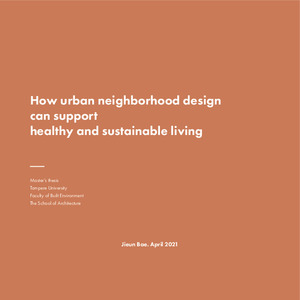How urban neighborhood design can support healthy and sustainable living
Bae, Jieun (2021)
Bae, Jieun
2021
Arkkitehdin tutkinto-ohjelma - Master's Programme in Architecture
Rakennetun ympäristön tiedekunta - Faculty of Built Environment
This publication is copyrighted. You may download, display and print it for Your own personal use. Commercial use is prohibited.
Hyväksymispäivämäärä
2021-05-18
Julkaisun pysyvä osoite on
https://urn.fi/URN:NBN:fi:tuni-202104273953
https://urn.fi/URN:NBN:fi:tuni-202104273953
Tiivistelmä
The main aim of this thesis is to research how urban neighborhood design can support and enhance health and well-being and more sustainable living. Based on design principles that support and enhance sustainability and citizen’s health and well-being, five design criteria are developed. Each criterion is further studied, and keynotes are taken away and act as a checklist for the neighborhood-scale plan.
For the case studies, three neighborhoods were selected based on similarity of context with Kalasatama, the chosen design area. The cases, which claim sustainable neighborhoods as their main aim, as well as the initial plan of Kalasatama are evaluated with five developed criteria. The aim is to make five criteria and related lessons that can be used for designers and developers to check as a precondition to design healthy and sustainable places which can promote people to have healthy and sustainable lives.
Finally, the design for the northern part of Kalasatama is suggested. The five criteria are used as an evaluation tool during the process, and the ultimate design is developed based on the result of this evaluation. The design process shows how these criteria can be used in the design phase and turn theory into practice.
This thesis suggests that neighborhood design should pursue health and well-being aspects and the inevitability of compromise for some sustainability criteria. The thesis also raises some questions and highlights issues about Finland’s current prevalent housing typology. For example, one of the biggest problems turns out to be the distance between buildings, which does not consider the Finnish climate.
For the case studies, three neighborhoods were selected based on similarity of context with Kalasatama, the chosen design area. The cases, which claim sustainable neighborhoods as their main aim, as well as the initial plan of Kalasatama are evaluated with five developed criteria. The aim is to make five criteria and related lessons that can be used for designers and developers to check as a precondition to design healthy and sustainable places which can promote people to have healthy and sustainable lives.
Finally, the design for the northern part of Kalasatama is suggested. The five criteria are used as an evaluation tool during the process, and the ultimate design is developed based on the result of this evaluation. The design process shows how these criteria can be used in the design phase and turn theory into practice.
This thesis suggests that neighborhood design should pursue health and well-being aspects and the inevitability of compromise for some sustainability criteria. The thesis also raises some questions and highlights issues about Finland’s current prevalent housing typology. For example, one of the biggest problems turns out to be the distance between buildings, which does not consider the Finnish climate.
